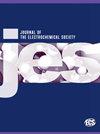掺杂 RuO2 的铋金属卟啉框架衍生 Bi2O3-RuO2@C 复合材料用于高选择性二氧化碳电还原
IF 3.3
4区 工程技术
Q2 ELECTROCHEMISTRY
引用次数: 0
摘要
在二氧化碳的电化学还原(CO2RR)过程中,设计具有高效率和高选择性的电催化剂非常重要,也极具挑战性。本文提出了一种由二氧化钌和金属卟啉铋有机框架(Bi-TCPP MOF)衍生的三氧化二铋和 C 骨架组成的三元复合材料(称为 Bi2O3-RuO2@C)。纳米级 RuO2 和 Bi2O3 颗粒均匀地分布在 C 骨架上。基于铋金属卟啉的前体有机骨架限制了 Bi2O3 在骨架中的局部生长,而独特的高度共轭体系锚定了掺杂的 RuO2 颗粒,从而使活性位点和空穴富集中心均匀分布。同时,Bi-TCPP MOF 衍生的碳骨架具有良好的导电性,大孔结构也有利于气体的传输,从而合成了 Bi2O3-RuO2@C 作为 CO2RR 的电催化剂,并在电催化二氧化碳还原成甲烷(CO2-CH4)中表现出优异的催化性能和高选择性。当掺杂的 RuO2 含量为 20% 时,Bi2O3-RuO2@C 催化 CO2-CH4 还原的峰值法拉第效率可达 66.95%。重要的是,这项研究为利用 MOFs 构建高效催化系统的金属配比调节开辟了新天地。本文章由计算机程序翻译,如有差异,请以英文原文为准。
Bismuth Metal Porphyrin Framework Doped RuO2 Derived Bi2O3-RuO2@C Composites for Highly Selective CO2 Electroreduction
In electrochemical reduction of carbon dioxide (CO2RR), the design of electrocatalysts with high efficiency and selectivity is very important and challenging. In this paper, a ternary composite consisting of ruthenium dioxide and bismuth metal porphyrin-based organic framework (Bi-TCPP MOF)-derived bismuth trioxide and C skeleton has been proposed (denoted as Bi2O3-RuO2@C). Nanoscale RuO2 and Bi2O3 particles are uniformly distributed on the C skeleton. The precursor bismuth metal porphyrin-based organic framework restricts the localized growth of Bi2O3 in the framework, while the unique, highly-conjugated system anchors the doped RuO2 particles, resulting in a uniform distribution of both active sites and hole-enrichment centers. Meanwhile, the Bi-TCPP MOF-derived carbon skeleton has good electrical conductivity, and the macroporous structure also facilitates the gas transport, which leads to the synthesis of Bi2O3-RuO2@C as an electrocatalyst for CO2RR and exhibits excellent catalytic performance and high selectivity for electrocatalytic carbon dioxide reduction to methane (CO2-CH4). The peak Faraday efficiency of Bi2O3-RuO2@C for catalyzing the reduction of CO2-CH4 can reach 66.95% when the doped RuO2 content is 20%. Importantly, this work opens up new horizons for metal ratio regulation in constructing efficient catalytic systems derived from MOFs.
求助全文
通过发布文献求助,成功后即可免费获取论文全文。
去求助
来源期刊
CiteScore
7.20
自引率
12.80%
发文量
1369
审稿时长
1.5 months
期刊介绍:
The Journal of The Electrochemical Society (JES) is the leader in the field of solid-state and electrochemical science and technology. This peer-reviewed journal publishes an average of 450 pages of 70 articles each month. Articles are posted online, with a monthly paper edition following electronic publication. The ECS membership benefits package includes access to the electronic edition of this journal.

 求助内容:
求助内容: 应助结果提醒方式:
应助结果提醒方式:


